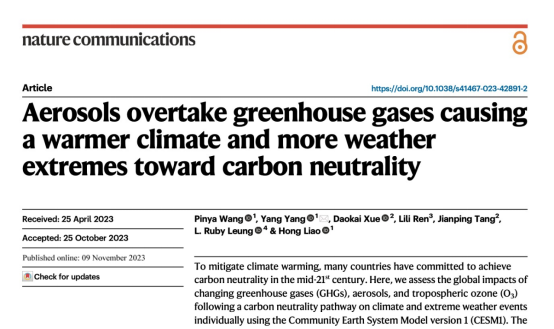-

Aerosols overtake greenhouse gases causing a warmer climate and more weather extremes toward carbon neutrality Due to human activities, atmospheric greenhouse gas (GHG) concentrations have increased dramatically since around 1750, causing the climate to warm in the last few hundred years. The rate of global warming has accelerated in recent decades, with the global mean surface air temperature rising by 1.1 °C above the pre-industrial levels.Under the 2015 Paris Agreement, many countries agreed to cut g... 2023-11-09
-

Accelerated deprotonation with a hydroxy-silicon alkali solid for rechargeable zinc-air batteries Rechargeable Zn-air batteries have attracted great attention owing to their high energy densities, environmental friendliness, and low costs, in which the oxygen evolution reaction (OER) determines the charging efficiency. Recently, the development of efficient oxygen electrocatalysts has been seen as pivotal in realizing practical Zn-air batteries. Transition metal oxides are important oxyg... 2023-11-01
-

Global population exposure to landscape fire air pollution from 2000 to 2019 In recent years, with the intensification of global warming, the frequency of wildfires (referring to uncontrolled or unplanned fires burning in wildland vegetation) has been increasing globally, posing a serious threat to the environment and public health. The smoke produced by wildfires can cause severe air pollution, often affecting areas hundreds or even thousands of kilometers away. The i... 2023-09-20
-

A synergistic ozone-climate control to address emerging ozone pollution challenges Tropospheric ozone affects human health, crop yields, exacerbates global warming, and plays a crucial role in atmospheric chemistry processes. Previous studies have shown an increasing trend in tropospheric ozone under the influence of factors such as anthropogenic emissions and climate change, causing over 300,000 premature deaths globally each year. Particularly, surface ozone has attracted ... 2023-08-18
-

Winter particulate pollution severity in North China driven by atmospheric teleconnections North China frequently experiences severe particulate pollution days (SPPDs, days when the daily mean concentration of particulate matter <2.5 μm (PM2.5) exceeds 150 μg m−3) in boreal winter, which have essential impacts on visibility, ecosystems, human health, and climate. Although stringent clean-air regulations have since been implemented in China, and the annual mean PM2.5 concentra... 2022-04-21
-

Abrupt emissions reductions during COVID-19 contributed to record summer rainfall in china Fig. 1 Extreme precipitation in China contributed by emissions reductions during COVID-19.In the early and middle summer of 2020, persistent extreme precipitation events occurred in eastern China. The accumulated rainfall has broken its 50-year record since 1961. Eastern China, as one of the most urbanized and densely populated regions in the world, suffered severe damages and losses from this ... 2022-02-18
-

Balancing hydrogen adsorption/desorption by orbital modulation for efficient hydrogen evolution catalysis Because of its potential value in efficient and scalable hydrogen production, water splitting via the electrochemical hydrogen evolution reaction (HER) has attracted considerable attention from industrial and scientific communities. Even though they are the heart of hydrogen evolution catalysis, catalysts with satisfactory performance are still rare, despite the tremendous effort that has been ... 2019-09-06
-

Identifying the structure of Zn-N2 active sites and structural activation Active sites are at the heart of catalysts, while the nature of active sites plays a key role in the performance of catalysts. During the past decade, the active sites of transition metal–nitrogen–carbon (TMNC) catalysts have not been well identified and are simply defined as TM-Nxbased on information from X-ray photoelectron spectroscopy (XPS). Such rough recognition of active sites leads to... 2019-06-13

